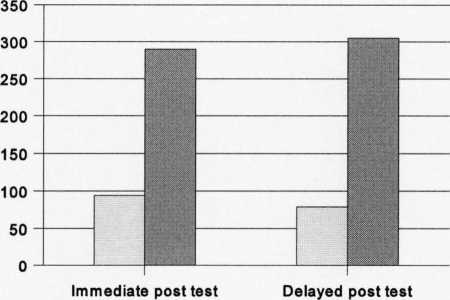5.4.2.2.2 Inference task
Scoring criteria for the inference task
In each trial the child had to answer two questions for the puppet. Each response was scored
1 for correct and 0 for incorrect. To be correct, the response had to be an appropriate answer
to the inference task, while incorrect was scored if the child provided an inappropriate
answer. All responses that provided correct information1 to the question were counted as
appropriate answers to the inference task (“What do we do with the x?”). Each child could
get a score from 0-2.
Analysis
If all children were correct on the two target words, the maximum total score would be 384
for all the participants in each post test. Figure 5.7 below illustrates children’s performance
on the inference task for both post tests. It can be seen that during the immediate post test
children provided 290 correct responses, while during the delayed post test they provided 305
correct responses. The inference task was quite an easy task for them.
Figure 5.7 Children’s performance on the inference task for both post tests

I I Don't know∕irrelβvant responses
I I Correct responses
To what extent does children ,s performance on the inference task differ by age ?
If all children from each age group were correct on the two target words, the maximum total
score would be 128 for each age group in each post test. Figure 5.8 demonstrates children’s
1For the present task appropriate answers were those responses which focused on the
action of the object and the functional properties of the object (see Error analysis)
127
More intriguing information
1. On Dictatorship, Economic Development and Stability2. A novel selective 11b-hydroxysteroid dehydrogenase type 1 inhibitor prevents human adipogenesis
3. The name is absent
4. The name is absent
5. A simple enquiry on heterogeneous lending rates and lending behaviour
6. The Determinants of Individual Trade Policy Preferences: International Survey Evidence
7. Testing Panel Data Regression Models with Spatial Error Correlation
8. Input-Output Analysis, Linear Programming and Modified Multipliers
9. On the origin of the cumulative semantic inhibition effect
10. Deprivation Analysis in Declining Inner City Residential Areas: A Case Study From Izmir, Turkey.